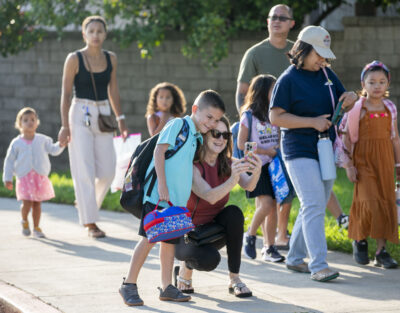In alignment with new California law, the William S. Hart Union High School District governing board is expected at Wednesday’s meeting to discuss the first reading of a policy concerning the student usage of cell phones.
Such a policy must be implemented by school districts across the state by July 1, 2026, following the passage and signing of Assembly Bill 3216.
Hart district governing board members have been talking about wanting a policy concerning cell phones since before that bill was passed by the Legislature, with board member Joe Messina saying at the board’s Nov. 21 meeting that it’s something that should be implemented sooner rather than later.
“We are constantly hearing from counselors about depression and anxiety and all this that we know was somewhat brought on by (cell phones),” Messina said at the meeting. “I don’t think we wait ’til the 2026. I’d like to see us kind of hyperspeed it.”
Prior to that meeting, results of a districtwide survey were released showing that students were overwhelmingly against a complete ban, but softened toward the idea of classrooms being phone-free zones.
The policy that is being introduced on Wednesday mirrors that idea, at least at the high schools.
“Students in high school must have smartphones or other mobile communication devices turned off and put away during instructional time,” reads a section of the draft of new board policy 5131.8. “Instructional time is defined as during the entire class period from bell to bell, and any other time during the school day when students are expected to be engaged in a learning activity. Students in high school may use mobile communication devices during breaks and before and after school, as long as the device is utilized in accordance with law and any applicable school rules. The district recommends that teachers utilize district-provided technology devices for instruction.”
Should the drafted policy eventually pass and be implemented as written, junior high students would have to have cell phones or other mobile communication devices “turned off and put away during the school day, both in and out of the classroom.” Junior highs already have that policy in place, but it is now set to be codified into a board policy.
Mobile communication devices are defined by the drafted policy as: cell phones, earphones/earbuds, tablets, laptops, gaming devices, smartwatches, smartglasses or any other device that connects to the internet or a cellular network.
Exemptions from the limitation of cell phones include the following:
- In the case of an emergency, or in response to a perceived threat of danger.
- When a teacher or administrator grants permission to the student to possess or use a mobile communication device, subject to any reasonable limitation imposed by that teacher or administrator.
- When a licensed physician or surgeon determines that the possession or use is necessary for the student’s health and well-being.
- When the possession or use is required by the student’s individualized education program.
Students who are found to be in noncompliance with the drafted policy would be subject to discipline, including temporary confiscation of the device.
The district would not be “responsible or liable for a student’s mobile communication device which is brought on campus or to a school activity and is lost, stolen, or damaged,” according to the draft policy.
Stakeholders would be included in discussions when the district chooses to review or update the policy to “ensure that the policy is responsive to the unique needs and desires of the school community,” the policy states. That would take place at least once every five years.
A pilot program has been in place at Canyon High School since the start of the 2024-25 school year in which cell phones are “off and away,” according to Canyon Assistant Principal David Miles, who spoke at the Nov. 21 meeting.
In most cases, cell phones are stored away in a phone pocket on classroom walls, Miles said. At the time, everyone involved seemed to know what to expect going in and, at that point, there hadn’t been too many issues, he added.
“A student made a comment the other day in a discussion with me about how students just feel like it’s less allowed,” Miles said, adding that as more time goes on, students will be more likely to see the policy as just the way things are rather than something new to get used to.
After implementing the pilot program at the start of the fall semester, Miles said 11% of students have received a violation and 4% have received two or more.
The key, he said, is having universal enforcement.
“It continues to be true that 100% classroom implementation with fidelity is still a goal rather than a reality,” Miles said, “and we understand that teachers do not want to be cell-phone police in their classrooms, and that it is tiresome to spend instructional time on cell phone procedure.”
The Sulphur Springs Union School District governing board had a similar policy introduced at a recent meeting and is set to have a second reading, and adoption, at a future meeting.
Josh Randall, deputy superintendent of business services for the Sulphur Springs district, said that draft policy is “very similar to our current practice.”
“Our current practice is that students need to have their phones off and in their backpacks,” Randall said at the Sulphur Springs board’s March 26 meeting. “One shift that this incorporates is also ensuring that smart watches can be left on but left in the backpacks.”
The Sulphur Springs draft policy includes language allowing for the usage of cell phones for medical reasons, Randall said, similar to the draft policy for the Hart district.
The Hart district’s governing board meeting on Wednesday is set to begin at 7 p.m. at the district’s administrative office, located at 21380 Centre Pointe Parkway.








